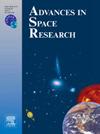关于赤道传播 F 的发生:多维量化评估
IF 2.8
3区 地球科学
Q2 ASTRONOMY & ASTROPHYSICS
引用次数: 0
摘要
本研究调查了在盛行电动力学和中性风调制的日落后背景条件影响下,重力波引起的种子扰动在发生赤道展宽F(ESF)中的作用。研究使用了特里凡得琅地磁赤道站(北纬 8.5°,东经 77°,磁倾角 0.68°N,与研究期间相对应)上的电离层 FoF 数据集,这些数据集对应于春分和秋分期间,包括高、低和中等太阳活动年。经向风数据来自欧空局的太阳同步卫星 GOCE(重力场和稳态海洋环流探测器),或利用特里凡得琅(TVM-8.5°N,77°E,磁倾角 0.68°N)和斯里哈里科塔(SHAR-13.7°N,80.2°E,磁倾角 6.9°N--研究期间)的电离层探测仪 h'F(2.5 兆赫的电离层基底高度)数据得出。这项研究是在春分(VE)和秋分(AE)这两个季节的地磁静止日进行的,这两个季节是印度经度地区发生 ESF 最有利的季节。考虑到热大气层风、离子中性碰撞和电场效应与重力波种子的关联,生成了阈值曲线,该曲线明确划分了 ESF 日和 NSF 日(无传播 F)。以前的研究仅涉及电动力学领域的 ESF 变异性(其中层高于阈值水平)。本研究通过同时纳入电场、中性风、碰撞 RT 不稳定项和重力波种子扰动的影响,首次成功地划分了 ESF 和 NSF 日,而不考虑阈值高度。本文章由计算机程序翻译,如有差异,请以英文原文为准。
On equatorial spread F occurrence: A multi-dimensional quantitative assessment
The present study investigates the role of gravity wave induced seed perturbations in the occurrence of Equatorial Spread F (ESF) under the influence of the post sunset background conditions modulated by prevailing electrodynamics and neutral wind. Ionospheric foF2 data sets over geomagnetic equatorial station Trivandrum (8.5°N, 77°E and magnetic dip 0.68°N-corresponding to the period of study) corresponding to vernal and autumnal equinoctial periods encompassing high, low and moderate solar activity years, are used for the study. Meridional wind data is obtained either from ESA’s sun-synchronous satellite GOCE (Gravity field and steady-state Ocean Circulation Explorer) or derived using ionosonde h’F (base height of ionosphere at 2.5 MHz) data from Trivandrum (TVM- 8.5°N, 77°E and magnetic dip 0.68°N) and Sriharikota (SHAR−13.7°N, 80.2°E and magnetic dip 6.9°N-for period of study). This particular study is carried out for geomagnetically quiet days of Vernal Equinox (VE) and Autumnal Equinox (AE) seasons, which are most favoured for ESF occurrence over Indian longitudes. Considering thermospheric wind, ion-neutral collisions, and electric field effects in association with gravity wave seed, threshold curve is generated, which clearly demarcates ESF and NSF (Non spread F) days. Previous studies have addressed ESF variability in electrodynamical domain alone (wherein the layer is above a threshold level). The present study, for the first time, succeeds in demarcating ESF and NSF days by incorporating effects of electric field, neutral wind, collisional RT instability term, and gravity wave seed perturbations simultaneously irrespective of threshold height.
求助全文
通过发布文献求助,成功后即可免费获取论文全文。
去求助
来源期刊

Advances in Space Research
地学天文-地球科学综合
CiteScore
5.20
自引率
11.50%
发文量
800
审稿时长
5.8 months
期刊介绍:
The COSPAR publication Advances in Space Research (ASR) is an open journal covering all areas of space research including: space studies of the Earth''s surface, meteorology, climate, the Earth-Moon system, planets and small bodies of the solar system, upper atmospheres, ionospheres and magnetospheres of the Earth and planets including reference atmospheres, space plasmas in the solar system, astrophysics from space, materials sciences in space, fundamental physics in space, space debris, space weather, Earth observations of space phenomena, etc.
NB: Please note that manuscripts related to life sciences as related to space are no more accepted for submission to Advances in Space Research. Such manuscripts should now be submitted to the new COSPAR Journal Life Sciences in Space Research (LSSR).
All submissions are reviewed by two scientists in the field. COSPAR is an interdisciplinary scientific organization concerned with the progress of space research on an international scale. Operating under the rules of ICSU, COSPAR ignores political considerations and considers all questions solely from the scientific viewpoint.
 求助内容:
求助内容: 应助结果提醒方式:
应助结果提醒方式:


